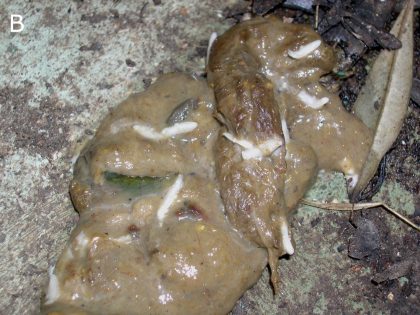Global epidemiology and molecular biology of Taenia multiceps
The latest Paper of the Month for Parasitology is Global epidemiology and molecular biology of Taenia multiceps: a comparative meta-analysis and in silico analysis study and is freely available for one month.
Do you know that there is a tapeworm that lives in the brain of sheep and goats and could also infect humans? Its name is Taenia multiceps and this article will explain some details of this important parasite worldwide widespread.
Taenia multiceps is a tapeworm parasitizing the small intestine of dogs and other wild canids. Infections in these primary hosts are asymptomatic; however, they serve as precursors for an overt disease that occurs in sheep, goats and occasionally in cattle.
Shepherd and stray dogs are very important in the transmission of T. multiceps. Infected dogs shed several T. multiceps gravid proglottids and/or eggs in their feces contaminating the environment, and eggs can survive for long periods. When sheep ingest contaminated pastures with eggs, they hatch and the embryos migrate through the blood circulation to settle in the central nervous system (CNS), particularly in the brain. They will develop into fluid-filled cysts of variable sizes (7– 10 cm at least) known as “coenurus” giving rise to a serious neurological disease known as cerebral coenurosis.

Cerebral coenurosis is usually fatal, and treatment of infected sheep mostly requires surgical intervention, which is not frequently practiced under field conditions and is commonly restricted due to financial concerns. The disease is well-known among small ruminant`s farmers in various regions worldwide, and can be manifested in 2 forms. The acute form often occurs in young animals due to the migrating embryos in the CNS tissue; the severity of lesions is correlated with the level of pasture contamination with the eggs. Infected animals then experience a quiescent phase for up to 7 months, during which the coenuri mature and gradually grow to form space-occupying lesions and cause neurological symptoms. Many chronically-infected animals that have small-sized coenuri in their brains appear symptomless, resulting in underestimated infections in the endemic regions. So, what about the susceptibility of sheep and goats to the cerebral coenurosis? Various field reports illustrated that sheep are prone to the disease more than goats. Is cerebral coenurosis in sheep and goats caused by the same T. multiceps strains? Based on earlier reports that analyzed limited number of samples, yes; this requires in-silico analysis of all available T. multiceps sequenced isolates.

In goats, however, the coenuri can also develop in various locations (e.g., subcutaneous tissues) other than the CNS and are termed “non-cerebral coenuri”. Why goat? This is largely unknown, but is thought to be related to a variant strain of T. multiceps. Are goats from various regions worldwide susceptible to infection with the non-cerebral coenuri? No, infections have been reported in goats from a few Asian countries, particularly Iran. Are sheep susceptible to infection with the non-cerebral coenuri? Yes, but very few cases have been reported from the same region.
There is also evidence that T. multiceps can circulate in sylvatic cycles including wild canids as well as wild ungulates (e.g., mouflon) in addition to the pastoral cycle (dog-sheep). Which wild canid is thought to play an important role in this parasite epidemiology? Various wild canids (e.g., foxes, wolves and golden jackals) can be infected; however, it is unknown which one is the most frequently infected, necessitating further analysis.

Humans can also be infected when accidentally ingest food contaminated with the eggs. The coenuri are formed in the brain, eyes and rarely in the spinal cord giving rise to serious complications. Around 45 cases of T. multiceps coenurosis from various age groups have been reported in humans worldwide; however, the disease is probably underestimated in humans. This article answers several key knowledge gaps in the epidemiology and molecular biology of T. multiceps, including: 1) the overall prevalence in dogs and other wild canids, 2) the overall prevalence in various intermediate hosts, 3) susceptibility of sheep and goats to cerebral and non-cerebral coenurosis, 4) variabilities in the occurrence of the disease among various regions worldwide, 5) coenurosis as a principal contributor to the neurological disease of sheep, and 6) genetic variability and population structure of T. multiceps-sequenced isolates from various definitive and intermediate hosts worldwide.
The paper Global epidemiology and molecular biology of Taenia multiceps: a comparative meta-analysis and in silico analysis study by, Ibrahim Abbas, El-Sayed El-Alfy, Somaya Saleh, Claudia Tamponi and Antonio Varcasia, published in Parasitology, and is freely available for one month.






